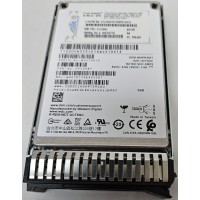IBM 5B2B 931GB SSD SAS 4k SFF-3 is a 2.5-inch 6Gb/s Mainstream solid state drive (SSD) formatted in 4k byte sectors and mounted on a SFF-3 carrier tray. IBM ESHS and ESHT SSD are physically identical solid state drives with the same IBM 5B2B CCIN and may have one of the following 01LU902 00LY559 01LU805 01LU829 02YC595 02YC646 02YC705 02YC844 as a part number, but use different feature codes to specify how the SSD is used. ESHS indicates usage by AIX, Linux or VIOS and ESHT is for IBM i. The IBM 5B2B CCIN may also have these common feature codes ESJ9 ESJ8 ELHS ES83 ES84 ESKL ESJS depending on IBM Power System Model, Operating System type and bay location the IBM configurator selected. The IBM 5B2B 931GB SSD has a 1 DWPD (Drive Write Per Day) rating calculated over a 5 year period.
The IBM 931 GB, 1.86 TB, 3.72 TB, and 7.45 TB capacity SSDs are designed to provide a lower cost per terabyte of SSD storage in a space-efficient footprint. A 2.5-inch SAS SSD is mounted on an SFF-3 carrier tray for a
Power9 or
Power8 system unit or mounted on an SFF-2 for placement in an expansion drawer such as the EXP24SX drawer when attached to a Power9 or Power8 server. The drive is formatted to use 4224-byte (4k) sectors and does not support the 4k JBOD 4096-byte sector. It also does not use the 512-byte or 528-byte (5xx) sector formatting.
When placed in Power9 or Power8 system units with SAS SFF-3 bays, the drive is run by the integrated SAS controller such as found in IBM Power L922, S914, S922, S924, H922, H924, S812L, S822L, S824L, S814, S812, S822, S824, E850, and E850C servers. When placed in the EXP24SX (SFF-2) storage enclosure, the drive is run by a PCIe3 SAS RAID adapter, such as the feature EJ0L, EJ14, EJ0J, EJ0M, EL3B, or EL59. These PCIe3 controllers support 4k drives on Power9 or Power8 servers. Earlier-generation SAS controllers don't support 4k drives.
When placed in an SSD array of one of these PCIe3 controllers, the array must be all mainstream SSDs or all non-mainstream SSDs. A SAS controller can currently run both 4k and 5xx drives, but they must be in separate arrays. Drives in an array should be the same or similar capacity. HDDs and SSDs can only be mixed in the same array when part of an Easy Tier® array (RAID 5TS, RAID 6T2, or RAID 10T2) provided by SAS RAID controllers such as the feature EJ0L or EJ14 or Power9 or Power8 integrated backplane controllers.
Like all SSDs, the performance of the 931 GB, 1.86 TB, 3.72 TB, and 7.45 TB mainstream SSDs are excellent compared to a disk drive (HDD). Read performance is on par with higher write endurance SSDs such as the enterprise SSDs. Write performance when compared to enterprise SSDs is somewhat slower but still more than 25 times that of a standard 15K HDD. As with any drive, either HDD or SSD, the number of drives is still a factor in achieving satisfactory performance, especially for IBM i.
These are mainstream drives and are not suitable for write-intensive workloads. Write-intensive workloads are those that write more to the drive each day than its rated capacity. Assuming a typical heavily random workload at about 3394 TB of writes to the drive, it will be at its maximum projected write capability. Writes past the drive's maximum write capacity will continue to work for some period of time, but much more slowly. A Predictive Failure Analysis message will indicate that it is time to replace the drive. If the predictive failure is ignored and writes continue to be sent to the drive, eventually the drive will be unable to accept write commands and will accept only read commands for a period of time. A failed write will result in a more serious error message indicating that the drive must be replaced.
The nature of the workload has a great impact on the maximum write capacity. For example, if a high percentage of more sequentially oriented writes is used instead of random writes, the maximum write capacity can be significantly larger. The user should occasionally check to see what percentage of the drive's write life remains and adjust the workload or drive assignment as it makes sense to do so. Checking is done by inspecting the SSD Mainstream Fuel Gauge. This capability is available through IBM AIX®, IBM i, and Linux®. The query or command to view the information varies by operating system. Check the remaining life of the mainstream drives individually, even if all are in the same array.
Depending on the nature of the workload, the lifetime TBW may be somewhat larger.
The drive is mounted on a SFF-3 carrier/tray to fit into a POWER8/POWER9 system unit's SFF-3 bays. JBOD formatting of 4096 byte sectors is not tested or supported. Drive cannot be reformatted to 5xx byte sectors. 5xx and 4k drives cannot be mixed in the same array. Older SAS adapters such as PCIe2 or earlier do not support 4k drives.
Attributes required: Open SFF-3 SAS bay controlled by PCIe Gen3 PCIe SAS adapter or later.









